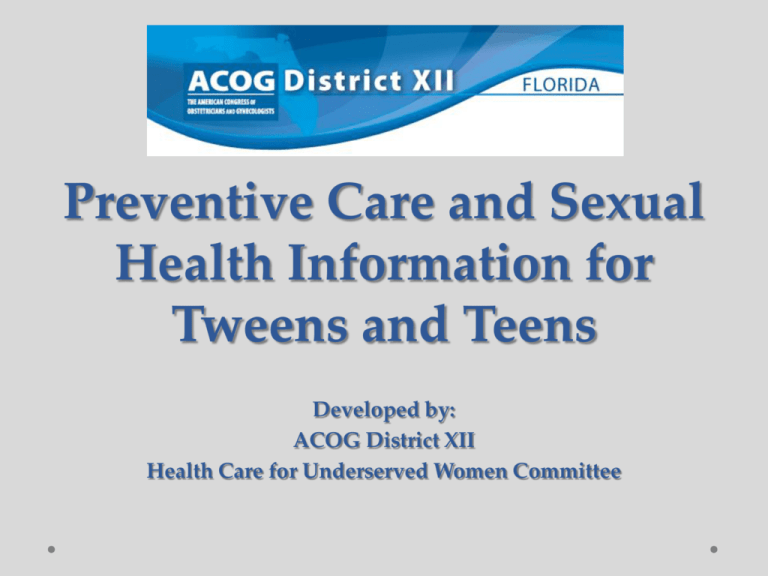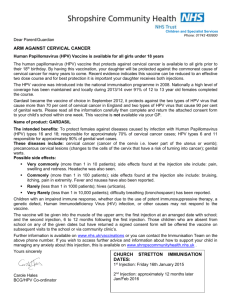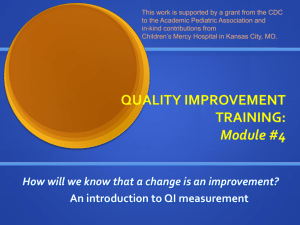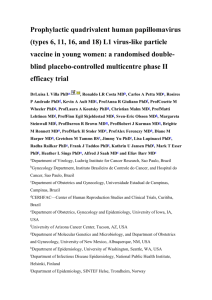
Preventive Care and Sexual
Health Information for
Tweens and Teens
Developed by:
ACOG District XII
Health Care for Underserved Women Committee
Lindsey M. McAlpin, MS,MD
• Resident Physician, Florida State University
College of Medicine, Department of Obstetrics and
Gynecology, Sacred Heart Hospital System, Pensacola, FL
o ACOG District XII Junior Fellow Vice Chair
• University of Texas Health Science Center Medical School,
Class of 2013
• Tulane University, Masters of Science, Department of
Neuroscience, 2009
• Tulane University, Bachelor of Science, Department of
Psychology and Neuroscience, 2008
• Tulane University, Bachelor of Arts, Department of Art
History, 2008
General Risk Factors for
Tweens and Teens
•
•
•
•
Poor Diet
Lack of Exercise
Smoking/Drugs/Alcohol
Early initiations of Sexual Activity
When Should You See an
Ob/Gyn?
• Ideally BEFORE there is a problem
• The American College of Obstetricians
Gynecologists (ACOG) recommends young
women see a obstetrician/gynecologist (Ob/Gyn)
between the ages of 13-15 years
Sexual Debut
• 62% 12th graders sexually active…
• ½ their mothers are unaware
Just the Facts……..
2002 Center for Disease Control (CDC) National
Survey of Family Growth
•11% of girls sexually active by age 13
•24% of girls sexually active by age 15
•40% of girls sexually active by age 16
•70% of girls sexually active by age 18
•Every 10 seconds, a teen becomes sexually
active
CDC Trends in Sexual
Début Girls, Ages 15-19
In Florida
2012 CDC 1991-2011 High School Youth
Risk Behavior Survey Data
•In the US, 6% of girls are sexually active by age 13,
•in Florida 8% of girls report sexually activity by 13
•Overall, 15% of US high students report having
sexual intercourse with 4 or more partners
•In Florida, 16% of high school students will have 4 or more
partners by graduation
•13% of high school students report that they did not
use any method to prevent pregnancy or
transmission of STIs during their last episode of
sexual intercourse
•12% of sexually active teens age 15-19 report not using contraception
More facts…….
• 12 million NEW Sexually
Transmitted Infections (STIs) cases
per YEAR
• 3 million of them are in TEENS
• 9,000 teen STIs per DAY
STI Facts
• Herpes Simplex Virus (HSV) 20 million active cases
• Human Papilloma Virus (HPV) 24 million active cases
• Human Immunodeficiency Virus (HIV)
More than 1 million active cases
HIV in Florida
• Florida is #3 nationwide for HIV
infections
• 1999: 5,424 new cases
• 22% of new cases are female
• 12 % age 15-24
Gonorrhea in Florida
(2000 Data)
• Total new cases per year: 25,000
people
• 127.8 cases/100,000 people
Chlamydia in Florida
(2008 Data)
• Total new cases per year=
75,000 people
• 389.1 cases/100,000 people
Teen Pregnancy
•
•
•
•
1997-183,324 births to 15-17 year olds in USA
1997-305,886 births to 18-19 year olds in USA
35% of all teen pregnancies are aborted
The teen pregnancy rates have started to decrease
• In 2011, there were 333, 746 births to adolescents age 15-19
5.1% of these were in Florida-ranked 25 out of 51 states and
territories
• Improved from 15 out of 51 in 2008
• 18% of these births were repeat births in
females under age 20
• 92% of these births occurred outside of
marriage
Teen Pregnancy
• 8 out of 10 teen moms live below
the poverty level for 10 years
• 9 out of 10 teen moms never finish
college
Pregnancy Prevention
• Communication between teens and
parents, counselors, trusted adults, and
partner is KEY
• Commit to your decision
• Date those that share your
views and values
• Avoid alcohol, tobacco, and drug use
• Safe sex-if your going to do it, be SMART
• Think of YOUR future
Consequences of Our
Choices……
•
•
•
•
•
Emotional effects
Physical effects
Future Fertility
Possibility of Cancer
Consequences and effects on loved
ones
When Should My
Daughter see a Ob/Gyn?
• Recommended first visit age 13-15
• Annually thereafter:
o To discuss problems with menstrual
cycles
o To check for STIs if sexually active
o To discuss/answer questions
about sexual activity
What to Expect from an
Initial Visit?
• History and Physical
o
o
o
o
History on menstrual cycle (period)
Examination to assess physical development
Screen for emotional and behavioral conditions/problems
Discuss/obtain immunizations
• Generally does not involve a Pelvic Exam
• All females aged 13-18 should receive annual
OBGYN visit
• Annual visit should focus on:
o
o
o
o
Healthy eating habits
Regular exercise
Avoiding tobacco/alcohol/drug use
Sexual activity
Consequences of Our
Choices……
•
•
•
•
•
Emotional effects
Physical effects
Future Fertility
Possibility of Cancer
Consequences and effects on loved
ones
HPV Infections can cause
CANCER
•
•
•
•
•
•
Cervical Cancer
Vaginal Cancer
Vulvar Cancer
Anal Cancer
Penile Cancer
Mouth and Throat Cancers
What, How, Where, and
Why of HPV
• Human papilloma virus
o More than 150 strains of the
virus, 40 of these infect the
human genital tract
o Can cause warts on both the
skin and genital tract
• Contracted by skin-to-skin
contact
o Genital strains of HPV are
contracted by engaging in
sexual activity with a person
who is already infected with
the virus
• Infection in the female
genital tract, especially the
cervix can lead to the
development of cancer
Prevalence of HPV
• Sexually active female college students were
found to have a baseline HPV infection rate
of 26%
• When these women were rechecked every 6
months, 60% were eventually found to be
HPV POSITIVE at least once over 3 year
period.
• 80% of sexually active women will contract
HPV at some point in their lifetime
Risk Factors for Developing Cervical Cancer
•
•
•
•
•
#1 Risk Factor=HPV
Number of partners
Age of first sexual contact
Smoking
HIV infection
Invasive Cervical Cancer
• 12,360 cases in the USA/year
• 4,020 deaths in the USA/year
• 16% of reproductive tract cancers
Role of the Pap Smear in
Cervical Cancer Prevention
• OBGYNs perform Pap smears to to screen
for pre-cancer and cancer cells in the cervix
• Start screening at age 21, then every 3 years
or more frequently if abnormal
• Responsible for 70% decrease in cervical
cancer deaths.
Pap Smears
What It IS
• Use of a speculum to look
at the cervix
• Collecting cells on the
surface of the cervix with a
special tool and looking at
them under a microscope
to observe for precancerous and cancerous
changes
What It ISNT
• A routine pelvic exam
• An STD screening for
other infections
(chlamydia, gonorrhea,
etc.)
We do Pap smears to try to
prevent cervical cancer after
women are already infected
with HPV.
But can we prevent HPV
infections before they occur?
What is the HPV
Vacccine?
Quadrivalent HPV Vaccine-Gardasil
• Produces immunity against the four HPV strains
that most commonly cause pre-cancerous
cervical changes and cervical cancer
o 6,11,16,18
• Approved by CDC in 2006
• Recommended for females ages 11-26
o Vaccine may be given to females as young as 9 years old
How Do I Get the
Vaccine?
• Vaccine is dispensed in 3 doses
o 1st-dose at visit,
o 2nd dose at two months
o 3rd dose at six months
• Through the Florida Department of
Health- Vaccine for Children (VFC)
Program
How Safe is the HPV vaccine?
• Vaccine was studied for a period of over 10
years
• Included 25,000 people
• 1,124 adolescent girls age 9-14
• Vaccine works against the virus particle,
not live virus vaccine
• Rare complications noted from 5 year
Scandinavian study
Is the Vaccine Effective?
• HPV 16 and 18 responsible for 70% of
cervical cancers
• HPV 6 and 11 cause 90% of genital warts
cases
• The vaccine is almost 100% effective
• Since introduction of the vaccine in 2006,
there has been a 56% reduction in HPV
infections in US adolescent girls, even
with low vaccination rates
o Research has also shown fewer cases of genital warts
New Developments
• Gardasil was FDA approved for
young men ages 9-26 in October 2009
• Cervarix is an additional FDA
approved HPV vaccine FDA approved
for ages 9-25
o Only covers HPV strains 16 and 18
o Does NOT prevent HPV associated warts (strains 6
and 11)
New Developments
• New vaccine in development
that covers 9 different HPV
types
What we have done..
With only a 33% vaccination in US girls, and
10% vaccination rate in US boys, rate we
have decreased the incidence of HPV by
56% in girls ages14-19!!!
BUT we can do better…
• Only 25.3% of eligible Florida
adolescent girls are getting
vaccinated
VS.
• 80% adolescent girls vaccinated in
Rwanda
We can prevent close to 33,000
cases of HPV linked cancer
cases annually with the HPV
vaccine
QUESTIONS?
Resources
• ACOG Pamphlet AP073 Human Papillomavirus (HPV) Infection
Jan 13
• ACOG Pamphlet AP167 Human Papillomavirus Vaccines Feb
2014
• cdc.gov/vaccines/teens
• cancer.gov/cancertopics/factsheet/Prevention/HPV-vaccine
• The initial reproductive health visit. Committee Opinion No.
598. American College of Obstetricians and Gynecologists.
Obstet Gynecol 2014;123:1143–7.
• Human papillomavirus vaccination. Committee Opinion No.
588. American College of Obstetricians and Gynecologists.
Obstet Gynecol 2014;123:712–8
• www.ImmunizationforWomen.org/HPV
References
CDC. Human papillomavirus vaccination coverage among adolescent girls,
2007–2012, and postlicensure vaccine safety monitoring, 2006–2013—United
States. MMWR 2013;62:591–5.
CDC. Quadrivalent human papillomavirus vaccine: recommendations of the
Advisory Committee on Immunization Practices. MMWR 2007;56(No. RR-2):1–24.
Markowitz, L. Hariri,S .Lin.C.,Dunnel,E. Steinau,E. McQuillan,G and Unge,E.
Education in Human Papillomavirus (HPV) Prevalence Among Young Women
Following HPV Vaccine Introduction in the United States, National Health and
Nutrition Examination Surveys, 2006–2010J Infect Dis. June 2013.
ACOG pratice Bulleton Number 131, November 2012 Screening for Cervical
Cancer.
US Department of Health and Human Services, Office of Adolescent Health







